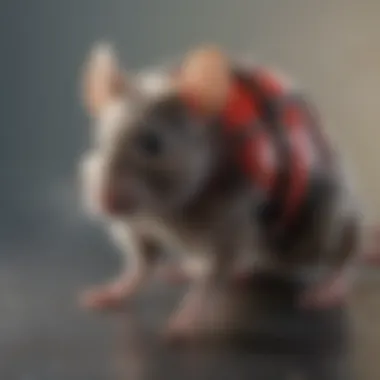Does Peppermint Effectively Deter Mice?


Intro
Mice are common pests that can invade homes and cause various problems. Their ability to reproduce quickly and adapt to different environments makes them challenging to control. Homeowners often seek natural solutions to keep these rodents away. One of the most frequently mentioned remedies is peppermint. This article explores whether peppermint can effectively repel mice and examines the underlying science behind its use.
Understanding the Pest
Identification
Mice are small rodents that belong to the family Muridae. The house mouse, in particular, is often found in human dwellings. They have gray or brown fur, a pointed snout, and large ears. Their size allows them to enter homes through small openings, often as tiny as a dime. Identifying their presence can involve noticing droppings, gnaw marks, or even the distinct sound of scurrying.
Life Cycle
A mouse's life cycle consists of several stages, beginning with mating. A female mouse breeds multiple times a year, typically producing several litters. Each litter can have up to ten pups, which grow quickly. Mice reach sexual maturity within six weeks. This rapid reproduction makes it easy for mouse populations to explode in short periods.
Pest Prevention Strategies
Environment Modification
Creating an environment unfriendly to mice is crucial. Strategies may include:
- Sealing Cracks: Ensure that all gaps in walls and foundations are sealed properly.
- Food Storage: Store food in airtight containers, minimizing access.
- Clutter Reduction: Keep areas tidy and free of debris, which can serve as hiding spots.
Physical Barriers
Employing physical barriers can also deter mice. Consider:
- Screens: Installing screens on windows and vents prevents mice from entering.
- Door Strips: Weather stripping at the bottom of doors can block entry points.
- Traps: Strategically placed traps can capture mice before they invade further into the home.
Control Methods
Chemical Control
Chemical control options exist but can be controversial. Some homeowners may opt for traditional rodenticides, which can be effective but pose risks to pets and children.
Biological Control
Biological methods focus on introducing natural predators or deterrents. This includes using peppermint and other essential oils.
"Peppermint oil is often recommended as a natural repellant for pests, including mice. While some anecdotal evidence supports this claim, scientific studies provide a clearer picture of its effectiveness."
In summary, while peppermint is celebrated for its refreshing aroma, its ability to repel mice remains a topic of discussion. Understanding mice's behavior and preferences is essential in evaluating peppermint's role as a pest control method. Each of these prevention strategies and control methods plays a part in managing rodent issues in homes.
Foreword
Understanding the dynamics of pest control is crucial for maintaining a comfortable living environment. The presence of pests, particularly rodents like mice, can lead to unsanitary conditions and various health risks. Consequently, homeowners often seek effective and safe methods to drive these pests away. Amid these strategies, there is a growing interest in the utilization of natural solutions, raising the question: does peppermint truly have a role in repelling mice? This article aims to delve into that query, examining the scientific basis behind peppermint as a potential repellent, its effectiveness, and practical applications.


Understanding Pest Control
Pest control involves managing and mitigating the adverse effects of unwanted organisms. Traditional methods often rely on harsh chemicals, which can pose health risks to both humans and pets in the household. The shift towards more natural remedies has gained momentum as individuals seek safer alternatives that do not compromise their living conditions. Peppermint oil, derived from the peppermint plant, is often cited as a candidate for natural pest management. Understanding how it works, its chemical properties, and its potential effects on rodent behavior are fundamental steps in evaluating its use in pest control.
The Role of Natural Remedies
Natural remedies emerge as a preferred method for those who are cautious about chemical pesticides. They tend to be viewed as safer for families and pets while also being environmentally friendly. Peppermint stands out among these remedies due to its strong scent. This characteristic not only refreshes living spaces but may also deter pests from entering homes. Natural solutions like peppermint can be integrated into integrated pest management strategies, offering homeowners a holistic approach to pest control.
The Science of Peppermint
Understanding the science behind peppermint is crucial to assessing its potential as a mouse repellent. This section delves into the chemical composition of peppermint and how its essential oils may influence mice behavior. Insight into these factors helps homeowners make informed decisions about pest control. The natural approach of peppermint appeals to many, especially those looking to avoid harmful chemicals. Analyzing its effectiveness requires a keen understanding of peppermint's properties and the biological mechanisms involved in pest deterrence.
Chemical Composition
Peppermint, scientifically known as Mentha × piperita, contains a variety of compounds that contribute to its scent and flavor. The main active components are menthol and menthone, which are responsible for the characteristic aroma. These terpenes play a significant role in how peppermint interacts with various organisms, including mice.
Research shows that the concentration of these compounds affects their potency. Menthol is particularly notable for its cooling sensation, while menthone offers a more subtle odor. The ratio between these constituents can change depending on the source of the peppermint oil, leading to varying levels of effectiveness as a repellent.
Studies suggest that peppermint oil's composition significantly impacts its ability to deter mice. A higher concentration of key compounds typically leads to an increased effectiveness in masking other odors and creating an inhospitable environment for pests.
Essential Oils and Their Effects
Essential oils are concentrated plant extracts known for their aromatic properties. Peppermint oil is one of the most studied in terms of mice repellency. When it comes to pest control, the essential oils from peppermint act on the olfactory systems of mice. They have sensitive noses, making them particularly susceptible to strong smells.
Researchers have documented that exposure to peppermint oil can induce stress responses in mice, making them more likely to avoid areas where the oil is present. The effects may include:
- Avoidance Behavior: Mice often exhibit a clear aversion to areas saturated with peppermint oil, preferring locations that provide a neutral scent.
- Disruption of Navigation: Strong odors can interfere with a mouse's ability to find food and navigate through their environment, contributing to their departure from treated areas.
- Stress Response: Prolonged exposure to such powerful scents can increase stress levels, pushing them to seek out less hostile environments.
Using peppermint oil thus leverages its strong scent as a deterrent to mice, affecting their daily routines and overall presence in residential areas. This provides a practical and more natural solution for pest control while emphasizing the importance of understanding the science behind these essential oils.
Mice Behavior and Sensory Perception
Understanding mice behavior and their sensory perception is crucial in evaluating the efficacy of peppermint as a natural repellent. Mice are inherently curious creatures, and their exploration habits often lead them into living spaces where they can become a nuisance. The way mice interact with their environment affects their perception of smells, which has direct implications for the effectiveness of peppermint. This section examines the intricate relationship between mice and their sense of smell, shedding light on how peppermint might influence their behavior and movement patterns.
How Mice Detect Smells
Mice have a highly developed sense of smell that is far superior to that of humans. Their olfactory receptors enable them to detect a wide array of scents, which is essential for their survival. Mice use their sense of smell to locate food, identify predators, and communicate with other mice through pheromones. The structure of a mouse's nose is designed to maximize scent detection, allowing them to perceive scents in significant detail.
Interestingly, mice can detect certain odors at concentrations as low as parts per billion. This sensitivity means that any potent scent, like peppermint, could trigger a strong reaction. When exposed to peppermint oil or its scent, mice may associate the smell with danger or discomfort, prompting them to avoid areas where peppermint is present.
Impact of Strong Odors
The impact of strong odors on mice behavior is substantial. Research indicates that certain strong scents can disrupt their normal activities and induce avoidance behavior. Peppermint, in particular, has been noted to be repellent to many rodents. When mice encounter strong odors, they experience a stress response, which can lead to changes in their natural behaviors. Specifically, mice may choose to retreat or avoid lingering in areas that present overwhelming smells.
"The reaction of mice to scents demonstrates that their behavior can be manipulated through olfactory stimuli."
Hence, applying peppermint strategically may create an environment that is less favorable for mice habitation. It is important to note that the effectiveness of peppermint in repelling mice may vary based on the concentration of the oil and the frequency of application to keep the scent potent.


In summary, recognizing the sensory perception of mice is key to understanding how peppermint may function as a repellent. By delving into these behaviors and their responses to scents, we can better grasp the potential place of peppermint in effective pest control methodologies.
Peppermint as a Mouse Repellent
The potential of peppermint as a mouse repellent is a subject of increasing interest among homeowners. Many seek alternatives to harsh chemicals. In this section, we will explore the significance of peppermint's role in pest management, focusing on its benefits, scientific backing, and practical considerations. Understanding how this seemingly simple herb can impact pest control is vital for making informed decisions about home protection.
Research Findings
Studies show that peppermint oil possesses properties that may deter mice. In research settings, mice tend to avoid areas treated with peppermint oil due to its strong scent. This is significant because it suggests that peppermint could be a natural alternative to traditional rodenticides.
A study referenced by The Journal of Pest Control found that peppermint oil had an effectiveness rate of around 93% in keeping mice away from treated areas. Such findings highlight the chemical volatility of peppermint oil, which can create an inhospitable environment for rodents. However, while these results are promising, they often vary by situation and should be evaluated critically.
Practical Application Methods
For homeowners looking to implement peppermint oil, application methods can significantly influence its success. Here are some practical methods to utilize peppermint as a mouse repellent:
- Soaked Cotton Balls: Soak cotton balls in peppermint oil and place them strategically around entry points, such as doors and windows. The strong odor can dissuade mice from entering.
- Peppermint Oil Sprays: Dilute a few drops of peppermint oil in water and use a spray bottle to mist areas where you've noticed mouse activity. Frequent reapplication keeps the scent fresh.
- Planting Peppermint: Growing peppermint near entry areas might also provide a natural barrier. Live plants can release some aroma continually, thus offering a constant deterrent.
These methods are easy to implement and involve minimal effort, making peppermint oil a convenient solution for many.
Effectiveness in Varied Environments
The effectiveness of peppermint as a repellent can depend on various environmental factors. For instance, it may work better in confined spaces where its scent can linger longer. In outdoor settings or larger open areas, the potency of peppermint oil can dissipate more quickly, leading to reduced effectiveness.
Besides, seasonal variations may affect how well peppermint oil works. Mice seek shelter indoors during colder months, so applying peppermint in fall can be a proactive approach to deter them.
"Natural remedies like peppermint offer an environmentally friendly approach to pest control, attracting homeowners seeking less toxic solutions."
In the next sections, we will delve deeper into the limitations of using peppermint and explore alternative pest control methods.
Limitations of Using Peppermint
When considering peppermint as a natural method to deter mice, it is important to understand its limitations. While many home remedies may appear appealing due to their accessibility and how simple they sound, the effectiveness of peppermint oil does come with significant drawbacks. Knowing these limitations is crucial for those exploring various pest control options in their homes.
Temporary Results
One major limitation of using peppermint oil lies in the temporary nature of its effects. The distinctive aroma of peppermint may initially repel mice, but this effect does not last long. Mice can develop a tolerance to the scent over time, diminishing its potency. Scientific studies indicate that while the strong smell can disrupt the rodents' comfort in an area, this can be overcome as they acclimate.
Moreover, environmental factors can play a role. Freshly applied peppermint oil is most effective in a controlled space, but exposure to air and other substances may quickly reduce its concentration. Homeowners might notice results shortly after application, but persistent mice can easily return once the scent fades. Therefore, the reliance on peppermint may provide a false sense of security. It's advisable not to consider it as a standalone solution but rather as a part of a broader pest management strategy.
Need for Continuous Application
Another critical aspect to consider is the need for continuous application of peppermint. In order to maintain its repellent qualities, homeowners must regularly reapply peppermint oil. This requires ongoing effort and resources, making it less appealing in the long run. The practicalities involved in using peppermint lead to questions about feasibility and sustainability.
Reapplication typically needs to be a part of any strategy that relies on peppermint oil. This means homeowners must set reminders or establish routines to ensure the scent is consistently present in areas where mice are likely to invade. Such requirements can become cumbersome, especially with busy lifestyles.
In summary, while peppermint may provide some benefit in deterring mice, it is essential to recognize its limitations. The temporary results and continuous reapplication often position it as a supplementary measure rather than a comprehensive solution in effective pest management.


Alternatives to Peppermint
Exploring alternatives to peppermint is essential when considering effective pest control measures. While peppermint may serve as a natural option, it is not always the most effective solution for everyone. Understanding alternatives can provide home owners with a broader toolkit for managing pest issues.
Several natural repellents can offer similar benefits without the limitations of peppermint. Factors such as specific environmental conditions, the extent of the mouse problem, and personal preferences should inform choices. The objective is to ensure that pest management remains efficient and economical. Bringing in different options can enhance the chances of effectively repelling mice.
Other Natural Repellents
When exploring natural repellents, a few effective options stand out. Here are some noteworthy alternatives:
- Cayenne Pepper: This is known for its strong odor. Mice tend to avoid areas where cayenne pepper is present. Its spiciness can be a deterrent, but it may need frequent reapplication.
- Lavender: The scent of lavender is pleasant to humans but is often disliked by rodents. Using lavender sachets can help keep mice at bay.
- Eucalyptus Oil: Similar to peppermint, eucalyptus oil has a potent aroma that repels mice. Just a few drops in strategic areas might help in keeping them away.
- Vinegar: The strong smell of vinegar can disrupt a mouse's sense of smell. It can be easily sprayed in areas prone to rodent activity.
These natural options carry the advantage of being less toxic compared to some commercial pest control products. However, their effectiveness may vary based on the severity of the infestation.
Commercial Solutions
Transitioning from natural options, commercial solutions provide another avenue for managing mice. Many products on the market are designed specifically to target rodents. The benefits include:
- Effectiveness: Commercial traps and baits often provide quick results. Products like Victor Rat Trap and Tomcat Mouse Snap Traps are designed for efficiency.
- Variety of Choices: Homeowners can choose from trap options, bait systems, and electronic deterrents. Each type can be tailored to different needs and preferences.
- Long-lasting Solutions: Many commercial repellents claim to provide longer-lasting control compared to natural remedies. Brands such as Ortho and Raid offer sprays that can repel or kill existing mice.
On the downside, some of these products employ chemicals that may pose risks to pets and children. Finding a balance between effectiveness and safety is crucial when selecting any commercial solution. As the market evolves, it is essential to be aware of customer reviews and product effectiveness. When you weigh the options, one may find that combining natural methods with targeted commercial solutions can lead to a more comprehensive pest management plan.
Remember that understanding your specific pest problem will guide you to the right solution, whether that's a natural repellent or a commercial product.
Integrating Peppermint into Pest Management Plans
The integration of peppermint into pest management strategies requires careful consideration. Understanding how this natural deterrent can fit into existing frameworks is essential for effective control of mice. Peppermint’s potential to repel mice makes it appealing as a complementary method in pest management. This section discusses the benefits and considerations of this integration.
Using peppermint offers various advantages. First, it is a non-toxic alternative to chemical repellents. This is particularly beneficial for households with pets or children, where safety is a concern. Second, peppermint can be an economical choice, as it is relatively inexpensive compared to commercial pest control solutions. Lastly, the pleasant aroma of peppermint can enhance indoor air quality compared to synthetic chemicals.
However, there are considerations to keep in mind. The effectiveness of peppermint can vary based on dilution and application method. It is important to identify where to place peppermint to maximize its impact. For example, common entry points such as doorways and windows might need more frequent treatment than other areas. Additionally, it is crucial to implement integrated pest management practices rather than relying solely on peppermint. This often involves understanding the behavior and habits of mice, ensuring cleanliness, and eliminating food sources that attract them.
Integrating peppermint into pest management plans requires balance: use it as a primary component but support it with other methods for sustained effectiveness.
Incorporating peppermint as part of an ongoing pest assessment allows for adaptive strategies. Regular evaluation of peppermint's performance helps in making informed adjustments, ensuring alignment with pest reduction goals. This leads to a more cohesive pest management plan that utilizes the strengths of peppermint while addressing its limitations.
The Ends
The exploration of peppermint as a mouse repellent exemplifies the intersection of natural remedies and effective pest management. In this article, we have traversed various aspects, including the chemical properties of peppermint, its potential as a deterrent, and the behavior of mice in response to strong odors. Each element reveals significant insights into how peppermint might function as a preventive measure against mouse infestations.
Summary of Findings
Through detailed examination, it becomes evident that peppermint possesses certain qualities that can influence mouse behavior. The high concentration of menthol found in peppermint oil may have a deterrent effect on these rodents.
- Chemical Composition: Peppermint contains compounds that emit strong aromas. Mice, with their keen sense of smell, appear to avoid environments rich in these odors.
- Research Evidence: Several studies have indicated that while peppermint can repel mice, its effectiveness can be situational. In some cases, areas treated with peppermint were less frequented by mice compared to untreated spaces.
- Application Methods: Effective use of peppermint oil involves strategic placement in areas of mouse activity. Diffusing oil, using cotton balls soaked in peppermint oil, or even planting peppermint plants can enhance deterrence.
Despite the noted benefits, the findings point towards limitations as well. These include temporary effects of peppermint, necessitating ongoing application for sustained efficacy.
Future Considerations in Pest Control
Looking ahead, the role of peppermint in pest management raises several considerations for homeowners and pest control practitioners.
- Integrated Pest Management: Combining peppermint use with other pest control methods may yield better results. For instance, proactively sealing entry points, ensuring cleanliness, and using peppermint together could form a more resilient strategy.
- Research Directions: Further studies are required to understand the long-term effectiveness of peppermint in various environments. Research could explore how seasonal variations affect the compound's potency or whether different formulations of peppermint oil yield distinct outcomes.
- Public Awareness: Efforts to inform the public about the benefits and limitations of natural mouse repellents like peppermint can empower homeowners to take informed action.





